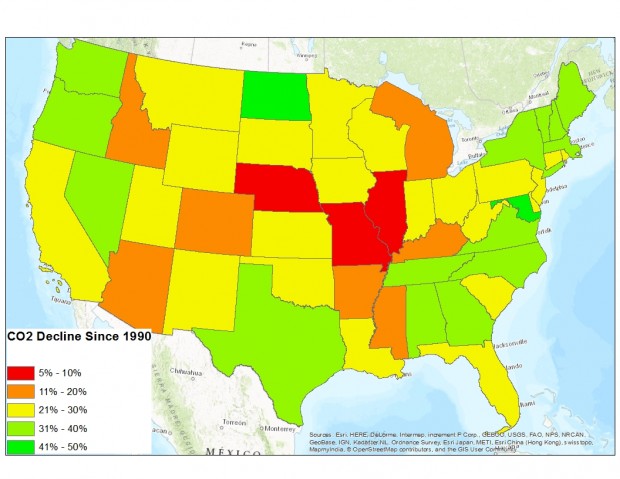Democrat-voting states have been slow to cut carbon dioxide (CO2) emissions compared to states that vote Republican, according to an analysis of federal emissions data by The Daily Caller News Foundation.
The amount of U.S. CO2 emissions per dollar of economic output has declined 28 percent since 1990, according to data from the Energy Information Administration (EIA). The decline hasn’t been evenly distributed throughout the country, and traditionally Republican states have been the quickest to reduce emissions.
Red state economies, which The DCNF defined as mostly voted Republican during the past six presidential elections, saw larger drops in the carbon dioxide (CO2) emissions than blue state economies. Those states made up seven of the top 10 states ranked by how much they reduced CO2 emissions, The DCNF found. Of the 20 states which beat the national average in terms of CO2 cuts, 13 were red states.

Source: Created By The Daily Caller News Foundation, Data Aggregated From Energy Information Administration
North Dakota’s economy cut its CO2 emissions by nearly 45 percent since 1990, despite an oil boom. The state voted for the Republican Presidential candidate in every election during the study period.
Other red states such as Alaska, Tennessee, North Carolina, Texas, Georgia and Alabama all had enormous CO2 declines of over 30 percent since 1990. The other rapidly greening state economies included swing states like New Hampshire, Virginia and Nevada. Each of these states had declines of more than 30 percent since 1990.
Illinois, which voted for the Democratic presidential candidate in every election during the study period, saw the smallest CO2 decline per unit of economic output, falling by less than 10 percent since 1990. The average Illinois household still uses 44 percent more energy than the average American household, according to the EIA’s Residential Energy Consumption Survey. The state is also very dependent upon coal power because Illinois “missed” the natural gas boom and hasn’t transitioned its energy sector towards natural gas.
Michigan, which voted for the Democratic Presidential candidate in every election is another example of a deep blue state failing to go green. The state’s emissions fell by a mere 15 percent since 1990 because the state’s economy is still 50 percent coal powered. Instead of transitioning towards natural gas, the state invested heavily in the wind power industry which hasn’t replaced coal as quickly.
Texas and Georgia are red states with economies comparable in size to Illinois or Michigan. Both managed to transition rapidly to natural gas according to their EIA profiles and saw a much larger decline in CO2 emissions since 1990. Texas voted for the Republican Presidential candidate in every election during the study period and Georgia voted for the Republican Presidential candidate in every election except one, the 1992 election.
New York and Maryland were the only large states which always voted for the Democratic Presidential candidate during the study period to have large CO2 declines. However, both states, and other New England Blue states, rapidly transitioned to natural gas power.
The only red state economy to buck the trend was comparatively small Nebraska, which voted for the Republican Presidential candidate during every election in the study period. Nebraska obtains roughly 60 percent of its electricity from coal according to its EIA state profile. Missouri, which was the only other state to fall into the lowest category of CO2 emissions decline, is a battleground state with a history of voting for both parties by narrow margins.
The exceptions show that red states likely saw larger CO2 declines because they quickly switched to natural gas fired electricity, which emits far less carbon dioxide than conventional coal power.
Studies show that fracking for natural gas is responsible for almost 20 percent of the decline in CO2 emissions, while solar power is responsible for a mere 1 percent of the decline. For every ton of CO2 cut by solar power, fracking cut 13 tons.
Send tips to andrew@
All content created by the Daily Caller News Foundation, an independent and nonpartisan newswire service, is available without charge to any legitimate news publisher that can provide a large audience. All republished articles must include our logo, our reporter’s byline and their DCNF affiliation. For any questions about our guidelines or partnering with us, please contact licensing@dailycallernewsfoundation.org.


